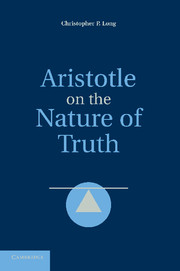Book contents
- Frontmatter
- Contents
- Prolegomenon
- Aristotle on the Nature of Truth
- 1 The Saying of Things
- 2 A History of Truth as Cor-respondence
- 3 Saving the Things Said
- 4 By Way of Address
- 5 By Way of Response
- 6 The Truth of Nature and the Nature of Truth in Aristotle
- 7 On Saying the Beautiful in Light of the Good
- 8 Ecological Justice and the Ethics of Truth
- Works Cited
- Index of Passages Cited
- General Index
2 - A History of Truth as Cor-respondence
Published online by Cambridge University Press: 06 December 2010
- Frontmatter
- Contents
- Prolegomenon
- Aristotle on the Nature of Truth
- 1 The Saying of Things
- 2 A History of Truth as Cor-respondence
- 3 Saving the Things Said
- 4 By Way of Address
- 5 By Way of Response
- 6 The Truth of Nature and the Nature of Truth in Aristotle
- 7 On Saying the Beautiful in Light of the Good
- 8 Ecological Justice and the Ethics of Truth
- Works Cited
- Index of Passages Cited
- General Index
Summary
We must start with tradition, and we must end with tradition criticized, clarified, and enlarged.
John Herman Randall, Jr., Nature and Historical ExperienceThat truth has always in some sense been a matter of justice can already be heard in the historical articulations we have inherited as the “correspondence theory of truth.” The origin of the correspondence theory has been explicitly traced to the statement from Aristotle's Metaphysics already cited in Chapter 1: “On the one hand, the false is to say [τὸ μὲν λέγειν] that what is, is not or that what is not, is; on the other hand, the true is to say that what is, is and what is not, is not, so that the one saying that it is or is not is either speaking the truth or is false.” We have already suggested that truth involves a saying that, in stretching out toward things, is capable of responding appropriately to the ways things ex-press themselves. ‘Ex-pression’ here means literally to press outward. It names the mode of presentation in which the unicity of things announces itself. Whatever else a correspondence theory of truth involves, at its core is an attuned ability to cor-respond to and with the expression of things. The etymology of the term ‘correspondence’ is instructive in this regard: ‘cor-’ is equivalent to ‘com-,’ which means “together,” and ‘respond’ is from the Latin respondēre, to answer. Correspondence describes the site of ontological encounter in which things respond together with one another.
- Type
- Chapter
- Information
- Aristotle on the Nature of Truth , pp. 21 - 48Publisher: Cambridge University PressPrint publication year: 2010
- 1
- Cited by



